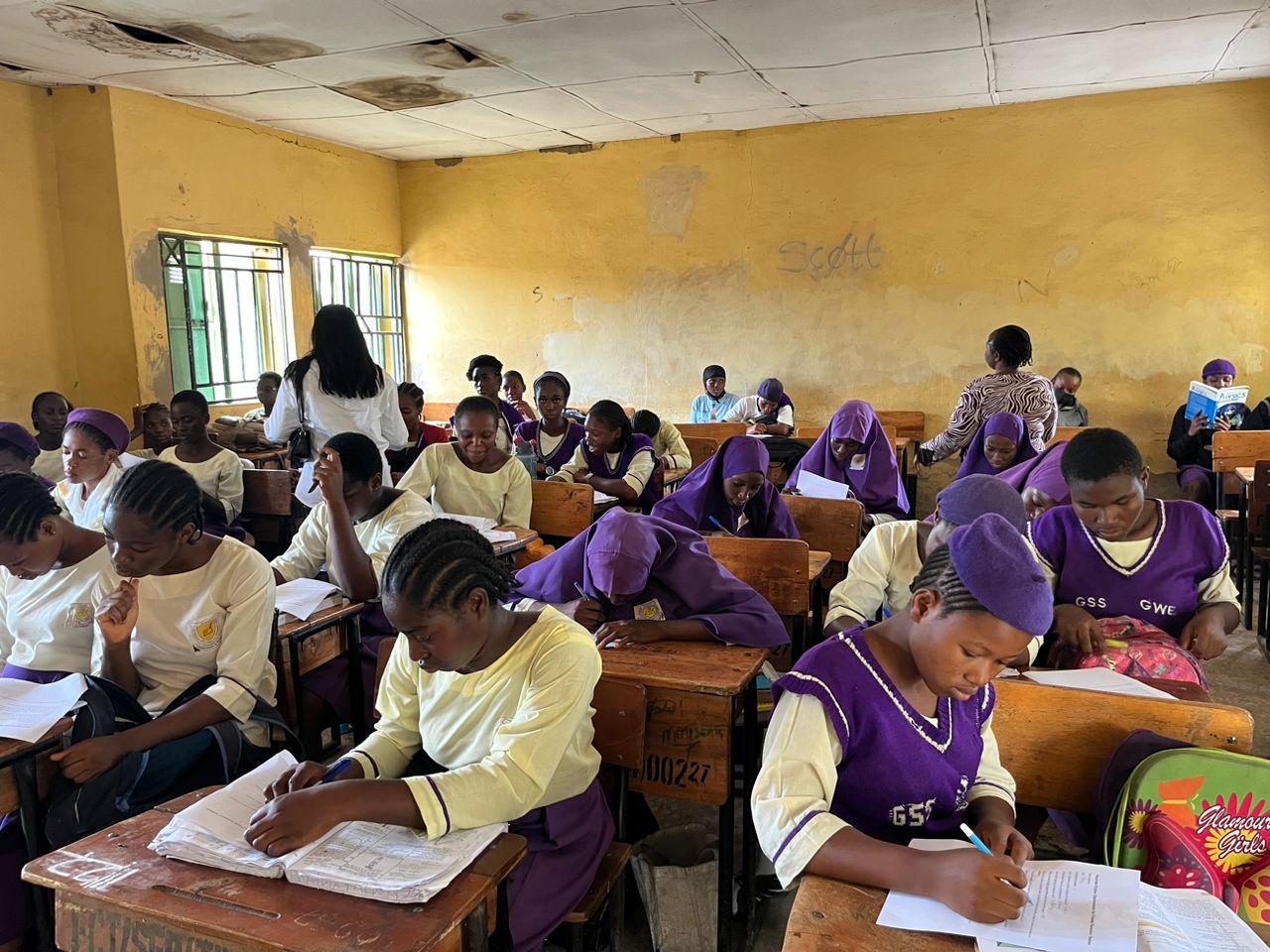BY DAWN IMMANUEL
Nigeria has made strong legal commitments to universal education. Yet for millions of girls, those promises still haven’t left the page. Their absence from classrooms is not from disinterest, but from systemic barriers that make learning a privilege instead of a right.
I sat before the cameras this week with EiE Nigeria to discuss “Beyond Safety: Addressing Policy Failures That Keep the Nigerian Girl Child Out of School,” and on sitting there, I realised again that we don’t suffer from a shortage of laws. We suffer from a shortage of follow-through. So, this is not a new conversation — it’s an unfinished one.
In Nigeria today, more than 7.6 million girls remain out of school (UNICEF 2024). For every 100 boys enrolled in secondary school, only 85 girls are. Behind each number is a dream deferred — a girl who wanted to learn but met a closed door.
Advertisement
The real problem is that our policies stop at paper. We have good laws (the Universal Basic Education Act and the Child Rights Act), yet they rarely travel beyond the text. So, our laws protect girls in ink, but not in action. Funding is inconsistent, implementation is shallow, and accountability is vague. Many states have not even domesticated the Child Rights Act, meaning the promise of compulsory education still depends on geography. And where policy ends, poverty, early marriage, and poor infrastructure step in to finish the job.
These remain some of the strongest barriers keeping girls out of school. For many families, free education still costs money — uniforms, books, exam fees, transport. When the choice is between feeding the family and keeping a daughter in school, school will always lose.
Early marriage follows closely, cutting short education before adolescence does. Even where families try, schools without WASH (Water, Sanitation and Hygiene) facilities, female teachers, or safe walk routes make attendance unsafe. So, it’s not that girls don’t want to learn; it’s that the system doesn’t make it easy to stay.
Advertisement
Beyond structural barriers like poverty and infrastructure, culture still shapes policy outcomes, often moving slower than legislation. Such that even when the law says every child must go to school, local norms sometimes still say “education spoils girls.” We can’t change that by confrontation; we must change it by collaboration. In faith-rooted communities, partnering with Imams, pastors, and traditional leaders to frame education as a spiritual duty — not a Western luxury — is far more effective. When faith and policy speak the same language, progress becomes possible.
True change won’t happen by decree alone. It takes community conversion. When traditional rulers, women’s cooperatives, and faith leaders become advocates for education — framing it as both moral duty and social investment — resistance turns into participation. In northern states where local imams have endorsed girls’ schooling as an act of faith, enrolment rises and dropout rates fall. Policy, when translated into culture, becomes progress.
Making Education Relevant: Teaching Skills That Families Value
One reason many families hesitate is that they don’t see practical value in formal schooling. For parents facing daily survival, a certificate years away feels abstract. But when education connects to skills, livelihoods, and visible opportunity, it becomes meaningful. We need schools that blend academics with real-world skills: literacy and numeracy alongside digital literacy, entrepreneurship, and creative trades such as tailoring, bead-making, or content creation.
Advertisement
This isn’t hypothetical. It’s working elsewhere:
Nigeria’s Adolescent Girls Initiative for Learning and Empowerment (AGILE) is embedding digital, leadership, and entrepreneurship skills into public schools, improving attendance and family support.
Educate! (Kenya, Rwanda, Uganda) combines academics with business and work-readiness. Over 90 percent of graduates now move into jobs, businesses, or higher education.
UNICEF’s Generation Unlimited and Learning Passport projects teach girls digital and life skills in fragile communities, helping parents see education as empowerment, not indulgence. When families see daughters earning, teaching, and leading even while in school, education becomes a source of dignity, not a distraction. We make education relevant, sustainable, and community-rooted.
Advertisement
A Rights-Based, Girl-Centred Framework for Nigeria
If we truly want every girl to learn, her right to education must be protected by design, not chance. Here’s what that looks like:
Advertisement
- Affordability: Eliminate hidden costs and introduce conditional cash transfers or school-feeding programs tied to attendance.
- Accessibility: Ensure every school has period-friendly WASH facilities, safe routes, and at least one female teacher.
- Accountability: Publish annual Girl-Child Education Scorecards ranking states by enrolment, retention, and funding use.
- Continuity: Re-entry policies for teen mothers and displaced learners; education that travels even to IDP camps.
- Community Voice: Parent circles, Mothers for School clubs, and boys’ clubs teaching respect and equality; letting culture transform itself from within. If we can measure it, we can fix it. Every state should be publicly ranked on how well it keeps girls in school.
We also don’t have to start from scratch or reinvent success. Other countries have shown us what works. In Bangladesh, for example, the Female Secondary School Stipend Program (FSSSP) offered families small monthly stipends for every girl who stayed in school and unmarried. They registered a rise in secondary enrollment from 1.1 million in 1994 to 4 million by 2001, closing the gender gap in a decade.
In India, the Educate Girls Initiative mobilised rural parents and community volunteers, bringing over 1.5 million girls back to school through coordinated village action.
Advertisement
Closer home, the Nigeria for Women Project boosted women’s income-earning activities by 9.5 percent and labor-force participation by 3.7 percent, proving that when women prosper, they reinvest in girls’ education. These programs work because they link learning to livelihood, and policy to people.
Beyond its moral urgency, girls’ education is an economic multiplier. The World Bank estimates that limited education for girls costs countries like Nigeria up to 30 billion USD in lost lifetime earnings each year. Educated girls grow into women who innovate, manage resources better, and reinvest up to 90 percent of their income in their families. When we keep girls in school, we don’t just change households; we expand GDP.
Advertisement
The numbers don’t lie. Globally, every additional year of schooling raises earnings by roughly 8–10 percent, and returns are often higher for women. Children of more educated mothers are far more likely to attend school. In Nigeria, children whose mothers have higher education attend early-childhood programs at a rate of 75 percent, compared to just 10 percent among those whose mothers have none (UNICEF 2024). UNESCO estimates that if all women completed at least primary education, child marriage and child mortality would each drop by about one-sixth.
Educating girls isn’t charity — it’s infrastructure. It’s as vital to nation-building as roads or power grids. We’ve talked about the problem for years; now the task is coordination, courage, and accountability. Protecting girls is only the beginning. Empowering them through learning is how we build a future that finally keeps its promises.
Dawn Immanuel is the head of school operations & administration at Propella Schools, and global communications lead at Celebration Church International
Views expressed by contributors are strictly personal and not of TheCable.










